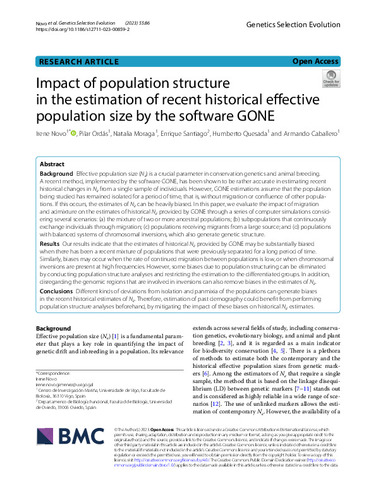Impact of population structure in the estimation of recent historical effective population size by the software gone
Autor(es) y otros:
Fecha de publicación:
Versión del editor:
Citación:
Resumen:
Background Efective population size (Ne) is a crucial parameter in conservation genetics and animal breeding. A recent method, implemented by the software GONE, has been shown to be rather accurate in estimating recent historical changes in Ne from a single sample of individuals. However, GONE estimations assume that the population being studied has remained isolated for a period of time, that is, without migration or confuence of other populations. If this occurs, the estimates of Ne can be heavily biased. In this paper, we evaluate the impact of migration and admixture on the estimates of historical Ne provided by GONE through a series of computer simulations considering several scenarios: (a) the mixture of two or more ancestral populations; (b) subpopulations that continuously exchange individuals through migration; (c) populations receiving migrants from a large source; and (d) populations with balanced systems of chromosomal inversions, which also generate genetic structure. Results Our results indicate that the estimates of historical Ne provided by GONE may be substantially biased when there has been a recent mixture of populations that were previously separated for a long period of time. Similarly, biases may occur when the rate of continued migration between populations is low, or when chromosomal inversions are present at high frequencies. However, some biases due to population structuring can be eliminated by conducting population structure analyses and restricting the estimation to the diferentiated groups. In addition, disregarding the genomic regions that are involved in inversions can also remove biases in the estimates of Ne. Conclusions Diferent kinds of deviations from isolation and panmixia of the populations can generate biases in the recent historical estimates of Ne. Therefore, estimation of past demography could beneft from performing population structure analyses beforehand, by mitigating the impact of these biases on historical Ne estimates.
Background Efective population size (Ne) is a crucial parameter in conservation genetics and animal breeding. A recent method, implemented by the software GONE, has been shown to be rather accurate in estimating recent historical changes in Ne from a single sample of individuals. However, GONE estimations assume that the population being studied has remained isolated for a period of time, that is, without migration or confuence of other populations. If this occurs, the estimates of Ne can be heavily biased. In this paper, we evaluate the impact of migration and admixture on the estimates of historical Ne provided by GONE through a series of computer simulations considering several scenarios: (a) the mixture of two or more ancestral populations; (b) subpopulations that continuously exchange individuals through migration; (c) populations receiving migrants from a large source; and (d) populations with balanced systems of chromosomal inversions, which also generate genetic structure. Results Our results indicate that the estimates of historical Ne provided by GONE may be substantially biased when there has been a recent mixture of populations that were previously separated for a long period of time. Similarly, biases may occur when the rate of continued migration between populations is low, or when chromosomal inversions are present at high frequencies. However, some biases due to population structuring can be eliminated by conducting population structure analyses and restricting the estimation to the diferentiated groups. In addition, disregarding the genomic regions that are involved in inversions can also remove biases in the estimates of Ne. Conclusions Diferent kinds of deviations from isolation and panmixia of the populations can generate biases in the recent historical estimates of Ne. Therefore, estimation of past demography could beneft from performing population structure analyses beforehand, by mitigating the impact of these biases on historical Ne estimates.
ISSN:
Patrocinado por:
This study forms part of the Marine Science Programme (ThinkInAzul) supported by the Ministerio de Ciencia e Innovación and Xunta de Galicia with funding from the European Union NextGenerationEU (PRTR-C17.I1) and European Maritime and Fisheries Fund. We also acknowledge fnancial support from grants PID2020-114426GB-C21 (MCIN/AEI/10.13039/501100011033), Xunta de Galicia (ED431C 2020-05), Centro singular de investigación de Galicia accreditation 2019–2022 and “ERDF A way of making Europe”. IN was funded by a predoctoral (FPU18 04642) grant from the Ministerio de Ciencia, Innovación y Universidades (Spain).
Colecciones
- Artículos [37543]
- Biología Funcional [801]
- Investigaciones y Documentos OpenAIRE [8377]
Ficheros en el ítem





